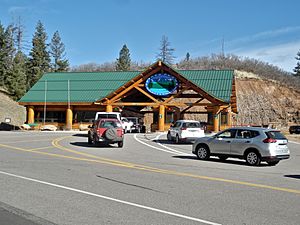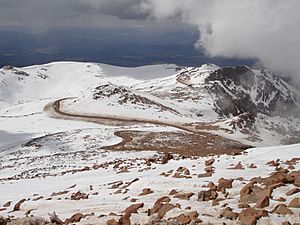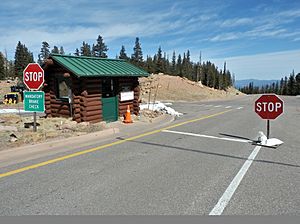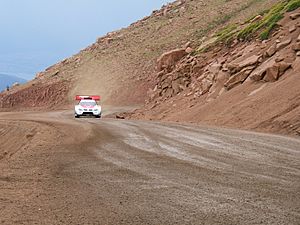Pikes Peak Highway facts for kids
The Pikes Peak Highway is a special road in Colorado that goes all the way to the top of Pikes Peak. It's about 19 miles (31 kilometers) long and is a toll road, which means you pay a fee to drive on it. This amazing road takes you to the summit of Pikes Peak, which is super high at about 14,115 feet (4,302 meters) above sea level!
The highway is usually open all year. However, if there's too much snow, parts of the road might close for safety. The cost to drive on the highway changes depending on the time of year. Sometimes it's a price per person, and other times it's a price per car.
Contents
Building the Road
The Pikes Peak Highway was built a long time ago, in 1915. A man named Spencer Penrose paid for it, and it cost about $500,000 back then.
Before this highway, there was an even older road called the Pike's Peak Carriage Road. It was built in 1888 and was very popular with tourists who wanted to see the top of the mountain. That old road closed in 1902.
Taking Care of the Highway
For a few years, from 1939 to 1947, the Colorado Department of Transportation (CDOT) helped take care of the road. But today, the city of Colorado Springs is in charge of keeping the Pikes Peak Highway in good shape.
Exciting Races!
The Pikes Peak Highway is famous for its exciting races!
Pikes Peak International Hillclimb
Since 1916, the highway has hosted an annual car and motorcycle race called the Pikes Peak International Hillclimb. Drivers race against the clock to see who can get to the top the fastest. It's also known as "The Race to the Clouds."
Pikes Peak Cycling Hill Climb
Another race held on the highway is the Pikes Peak Cycling Hill Climb. This bike race started in 2010. In 2016, it was even the first time the USA Cycling Hill Climb National Championship was held there.
Protecting the Environment
For many years, a part of the Pikes Peak Highway was made of gravel. This caused some problems for the environment.
The Problem with Gravel
A group called the Sierra Club noticed that a lot of gravel was washing away from the road each year. This gravel would fill up small mountain ponds and wetlands. It also covered the forest floor below, sometimes several feet deep. This was not good for the plants and animals living there.
The Solution: Paving the Road
To fix this problem, the Sierra Club and the City of Colorado Springs agreed to pave the unpaved parts of the highway. This meant covering the gravel with a hard surface like asphalt. Some people worried that paving the road would change the famous car and motorcycle race. For example, Rod Millen, a champion of the Pikes Peak Hill Climb, thought the race might end.
However, the paving project was finished on October 1, 2011. The race continued normally in 2012 and has been held every year since then. The Pikes Peak Highway is now a fully paved road, which helps protect the beautiful mountain environment.






